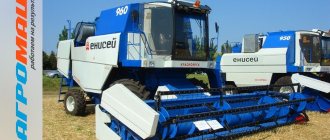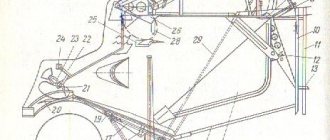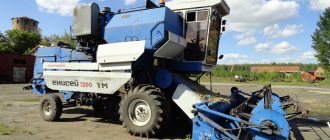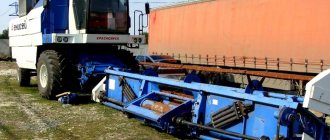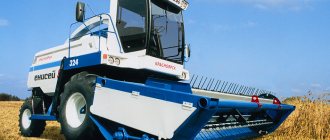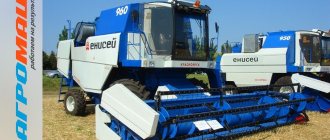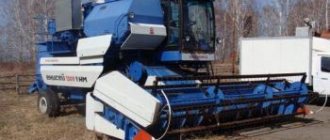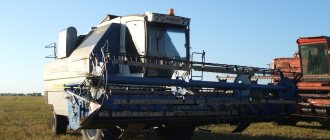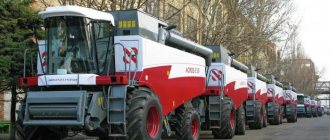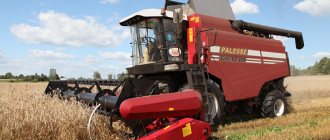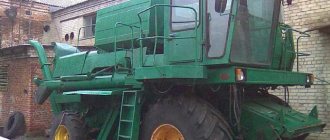The history of the creation of the Yenisei-1200 combine harvester
This is the most popular grain harvesting equipment in the USSR, located beyond the Ural Mountains. It began to be produced after the sixties at the Krasnoyarsk Combine Harvester Plant (KZK) with an area of twenty hectares. The enterprise was organized in 1941 on the basis of production facilities and technical equipment evacuated from the Zaporozhye enterprise Kommunar. During the Great Patriotic War, the KPC produced ammunition, mortars, and artillery shells using machines brought from the plant named after Alexei Ukhtomsky from the city of Lyubertsy. In 1944 it was directed to the creation of agricultural machines. In 1981, the Yenisei-1200 combine harvester was developed based on the experience of using the SK-5 Niva. And in 1986, 16,535 models of this equipment were manufactured and put on the market.
Offices instead of combines: Krasnoyarsk City has found a place
One of the city's intrigues this spring has been revealed: the largest business will be located not on Vzletka, as the authorities once planned, but on the territory of a former combine plant. The city's former industrial sites continue to be transformed into residential and business areas.
Project for the Krasnoyarsk City district: skyscrapers in the center, and on the shore, instead of the current factory fence, there is a wall of high-rise buildings
Let us recall that Alexander Uss announced plans to create a business district in the regional center during the annual report in April. At that time, no details were known, not even about where it could be built. (Although many thought about Vzletka, because it was there that the center of Krasnoyarsk had previously been planned to be moved. It was not for nothing that the regional committee of the CPSU was built there, demolished before the Universiade for the construction of the Crystal ice arena).
The governor in April only explained that the business center would unite the offices of large Russian companies, RUSAL, RusHydro, AFK Sistema, SUEK and Krasnoyarsk-Gazprom.
Then, in May, it became known that Uss presented the project to President Vladimir Putin during a meeting, noting that the idea that Krasnoyarsk could become an investment center not only for Siberia was “taking on real shape.”
Alexander Uss presents a project for a business center in Krasnoyarsk for leading Russian companies to Russian President Vladimir Putin
“It just so happens that large companies are beginning to consider Krasnoyarsk as a kind of investment center and are moving their management structures here. We don’t stop after the Universiade, we are transforming the city, making it better,” commented Alexander Uss.
The fact that the territory of the former combine plant was chosen as the site for construction became known during the off-site meeting of Alexander Uss. It is noteworthy that in “Krasnoyarsk City”, in addition to offices, there will also be apartments for living and leisure of employees.
The area of the office center will be 60 thousand square meters, it will accommodate up to 5.4 thousand workplaces.
This is how the designers see “Krasnoyarsk City” - from the upper floors of the towers there will be a beautiful view of the metropolis, the Yenisei and the Sayan Mountains
What “Krasnoyarsk City” can become, said Sergei Ladyzhenko, General Director of the Yenisei Siberia Development Corporation. Please note that these are only preliminary parameters of the future business center.
It is planned that Krasnoyarsk City will have top-class office space, as well as places for negotiations and presentations.
The apartments will be rented by employees of large companies, businessmen and city guests. In the center of the block there will be places for the whole family: restaurants, a fitness center and banks.
According to Sergei Ladyzhenko, a number of large Russian companies have already expressed their interest in the project, and the prerequisites for the formation of a business center of the highest level have been formed in the regional center.
“Today, active negotiations are underway to locate their offices in Krasnoyarsk City,” he explained.
Now the territory of the former plant is gradually being cleared
It should be noted that the governor’s visit to the construction site took place as part of a large-scale inspection of improvement facilities. The head of the region assessed more than ten projects on the right and left banks of the Yenisei in the regional capital, noting that Krasnoyarsk has changed significantly in recent years.
“The standard that was set at the Universiade is maintained, but we are moving on. Therefore, the detour today was not a ceremonial one, but a working and critical one. Now it is important to maintain order at those sites where improvement has been completed, to avoid mistakes that have happened, and to work efficiently where work is just beginning,” the head of the region emphasized.
The territory of the combine plant - its area is 70 hectares - is being developed by a large Krasnoyarsk developer USK Sibiryak, owned by Vladimir Egorov. In addition, on the first line – st. Bograda, on the site of the Che Guevara club, is building six houses.
Now that part of the plant territory that is closer to the center of Krasnoyarsk and the railway. station, is already being actively developed by two companies
According to the concept of development of the Sibiryak site, presented at the beginning of 2016, it was initially planned to build about 1 million square meters there. m of housing and 400 thousand sq. m. m of commercial space - for 30 thousand residents and 10 thousand employees. Including high-rise buildings up to 35 floors.
But plans changed, and in 2022, LLC Specialized Developer Residential Complex Novoostrovsky, which is a subsidiary of USK Sibiryak, received permission to build the Novoostrovsky residential area here, the project of which was developed back in 2015.
This is how the future Novoostrovsky district was seen five years ago:
According to this document, on a plot of 26 thousand square meters. m and a cadastral value of more than 93 million rubles, located within the boundaries of the street. Trade unions, Bograd and Robespierre, mid-rise residential buildings will appear. They will house more than 280 apartments and underground parking, as well as commercial space.
Elite houses with attic upper floors will be located in closed courtyards.
Sibiryak had previously cleared the territory - and the company owns almost the entire upper terrace of the former combine harvester plant - and achieved a change in its zoning. Initially there were 4 different zones, including a recreation zone from the station to the street. Dubrovinsky.
Let us remember that at one time the developer promised to preserve the view of the Yenisei, which opened after the demolition of the combine buildings and a direct road from the center to the embankment.
Descendant of “Kommunard”, “Stalinist” and “Sibiryak”
On April 13, 1944, the KPC produced the first combine harvester called the Krasnoyarsk Communard. By May 9, 1945, 350 units of these vehicles were produced. And in 1947, production focused on the Stalinets combine harvester equipment, which was serviced by one person and did not require a tractor. Its modifications SK-3 of 1959 and SK-4 of 1965 are transitional models on the way to the creation of the Sibiryak combine with increased throughput by 48%. It is equipped with two drums. Later, the plant produced a modification of the Sibiryak on caterpillar tracks for operation in high moisture conditions. And the SKD-5 Sibiryak is a self-propelled unit with a separate operator cabin. It was manufactured in the time period from 1969 to 1981.
Modifications and features
Yenisei 1200 1NM has been modernized several times. The most famous versions of the combine are:
- Yenisei 1200 1NM – basic modification with 1 threshing drum of the beating type;
- Yenisei 1200 1NMZ – version equipped with 1 tooth drum;
- Yenisei 1200 1НМШ – variation with 1 pin drum;
- Yenisei 1200 RM(G) – modification for working in rice fields and soils with high moisture content.
The Yenisei 1200 family contains many versions. The characteristics of each model can be determined from the name:
- H – variation for non-chernozem regions;
- M – modernized modification;
- P – tracked version used in rice fields;
- Z – tooth drum;
- Ш – pin drum;
- 1 – number of thresher drums (the absence of a number indicates the presence of 2 drums).
Features of Yenisei 1200 1NM:
- sufficient performance for this class;
- affordable price. Among cars with similar characteristics, it is unlikely that you will be able to find a cheaper option;
- high maintainability and ease of maintenance;
- reliable and powerful unit with a simple design;
- adaptation to Russian working conditions and the ability to operate on any type of soil, including rough terrain;
- versatility and a wide range of attachments used.
Disadvantages of Yenisei 1200 1NM:
- working conditions on the combine are quite difficult;
- low reliability. Regular breakdowns are a common thing for this model;
- low efficiency when operating in areas with a humid climate.
Technical characteristics of the Yenisei-1200 combine
The digital marking in the name indicates the width of the threshing machine, measured in millimeters. And the Yenisei-950 Ruslan combine, released in 2003, is a compact modification of the 1200 unit, which is designed for work in small areas. If we talk about the technical parameters of the Yenisei-1200, they are as follows.
Dimensional and mass indicators
- Dimensions (LxWxH) – 10.5x3.8x7.5m.
- Curb weight – 9.7t.
- Productivity – 9t/hour.
- The volume of the grain bunker is 4.5 cubic meters.
- The diameter of the drums is 5.5 m.
- Drum rotation speed – 1250 rpm.
- Header grip – from 5 to 7 m.
- Cutting height – 5-18cm.
- The productivity of the unloading auger is 17 kg/sec.
- Straw walker - four keyboards (each 2.82 m).
Combine engine
It is represented by three types: YaMZ-236/DK-2, D-442/57-I, D-442/50. They are in-line diesel engines, consisting of four cylinders and tracts. Their power is 185/170/145 horsepower, respectively. The fuel tank capacity is 0.3 cubic meters. The YaMZ engine is more economical, powerful and has a large reserve of torque. The power unit is mounted on combines behind the grain bin, on top of the thresher roof using shock absorbers. The water radiator is equipped with additional cooling. One side of the crankshaft transmits power to the thresher, and the other to the wheels, hydraulic pump, diesel generator, water pump, and fan.
Features of transmission, gearbox, control
Basic components of the equipment are controlled via hydraulics, and the steering wheel is equipped with a hydraulic booster. The hydraulic drive of the transmission is designed for easy control, smooth and even running, and good maneuverability. In addition, smooth running is ensured by metering pumps and hydraulic cylinders. There are two types of transmission on the Yenisei: mechanical or hydraulic. In accordance with it, the bridge of the driving wheels of the machine is equipped. The chassis is represented by low-pressure tires, increasing the contact area of the unit with the ground and its traction with low fuel consumption. The chassis of the combine requires an easily turning steering wheel even when the engine is idling and the power pump is not working.
Transmission
Various speed variator parameters are possible.
- Manual transmission - located on the axle, which is considered to be a drive axle, gear type. It has a locking mechanism. Gearboxes, called final drives, are of the planetary type. The clutch does not disengage; it is located on the shaft, which is the primary one.
- Hydraulic speed variator. Here the Yenisei combine is controlled using pedals. Then the separate brakes are activated by pressing the pedal. Gearbox consisting of three ranges. The diagram of the Yenisei combine shows its attachment to the bridge beam.
Modifications of Yenisei combines
The multifunctional Yenisei-1200 with high performance, which was produced for the purpose of further operation on vast fields in all weather conditions, became a classic and a base. It is equipped with a threshing mechanism with two crushing drums. Next came out:
- Yenisei-1200/1, 1M – modernized, 1NM – for non-chernozem soils. A sample with a five-meter header, an autonomous post-threshing mechanism and a single drum thresher.
- Yenisei-R, RM. A machine on tracks for collecting legumes, grains, sunflowers on swampy or waterlogged soil. Equipped with pin drums and a highly active straw walker.
- Model N. Option for non-black earth regions, equipped with a driving chassis from the T-150 K tractor and a steering one and with widened tires.
- Model 950/960. Latest serial modification. Compact and economical.
Design and service features
Among the main components of the Yenisei 1200 1NM model, the following should be highlighted:
- front header, which provides semi-automatic connection of the feeder chamber and the housing and copying of the surface topography in the transverse and longitudinal direction;
- 2 main fans with air flow separator;
- 2-stage wind screen with increased separating area and supercharging;
- drum-type finishing device.
Yenisei 1200 1NM is equipped with one thresher drum, which makes it more versatile and compact. Thanks to this feature, the equipment can be used on fields of small area and irregular shape.
Operating experience of the Yenisei-1200 combine: advantages and disadvantages
Manufactured for harvesting grains with losses kept to a minimum. Designed for large work areas. At small settings its performance is significantly lower. In accordance with feedback from the plant’s customers, imported equipment is preferable in many respects, but in terms of economic efficiency: low price, quick payback, lightweight design, high maintainability - no one can compare with the Yenisei-1200. Compared to the Niva, it is more comfortable and more productive. Especially the unit with the YaMZ engine. But its fuel consumption is higher, and spare parts are difficult to find. The only way out of the last problem is to adapt spare parts from Niva.
Engine
The combine's power plant is located on the roof of the threshing unit immediately behind the hopper. The engine is mounted on the main frame using shock absorbers. Yenisei 1200 1NM is equipped with 2 types of in-line engines:
1. 4-stroke diesel supercharged unit of the D-442 series (Altai Motor Plant). Characteristics:
- working volume – 6.3 l;
- rated power - 140 or 170 hp;
- number of cylinders – 4;
- average fuel consumption – 50 l/hour;
- fuel tank volume – 450 l.
YaMZ 236DK2
2. 4-stroke naturally aspirated diesel unit YaMZ 236DK2 (Yaroslavl Motor Plant). The engine is more modern and superior to the Altai plant product in power and efficiency. The motor is equipped with a liquid cooling system with forced circulation, driven by a pump. The drive is a belt that transmits rotation to the pump pulley from the crankshaft pulley.
- working volume – 11 l;
- rated power - 185 hp;
- number of cylinders – 4;
- average fuel consumption – 30 l/hour;
- fuel tank volume – 300 l.
The engines operate according to a similar pattern. The force is transmitted to the crankshaft and then to the thresher on one side and the chassis, water pump, hydraulic pump, fan and diesel generator on the other side.
Buying a used Yenisei combine harvester: features of choice
The sale of used Yenisei is common everywhere, so purchasing it will not be difficult. The price for this agricultural machinery varies from 150,000 to 1,200,000 Russian rubles. The higher the price, the fresher the car. And the lower it is, the higher the cost of its overhaul will be. Expensive units, as a rule, come with additional attachments and spare parts. Therefore, when choosing, it is important to pay attention to studying the technical condition, documents and equipment of the combine harvester.
In addition to the above advantages, the owners of this combine harvester note the reliable protection of the operator through the frame. And according to the general assessment, the Yenisei-1200 combine harvester is an excellent solution for a large agricultural or farming enterprise.
Device
The design of the Yenisei-1200 combine includes such mechanisms and systems as:
- Reel. This is a wolf (stem) picker, i.e. winding device.
- Cutting apparatus. He cuts off the stalks of the ears.
- Screw. This mechanism is necessary to transport the mass to the central part of the header and the fingers.
- Feeder chamber equipped with conveyor.
- Drum threshing type installation.
- Deca.
- Straw walker. This mechanism is designed to separate grain from straw.
- Board for transportation.
- Fan.
- Sieve.
- Grain bunker.
- Straw chopper.
- Combine operator cabin.
- Power unit.
- Impact beater.
- Mounting mechanisms. They are purchased separately from the equipment itself.
Engine
The manufacturer placed the four-stroke engine of the tracked combine behind the hopper compartment on the roof of the threshing mechanism. The four-cylinder engine is attached to the frame using shock absorbers.
An intermediate type cooling system is installed in front of the radiator. It is necessary to reduce the temperature of the incoming hot air flow.
From the left side of the crankshaft, the motion signal is transmitted to the clutch, and from there to the threshing mechanism. The left side of the crankshaft directs the impulse to the hydraulic pump or stroke piston. In the same way, power is transferred to the fan, generator and hydraulic pump.
There are several engine modifications for this combine model; the engine power can reach 185 hp. With.
Transmission
Depending on the selected configuration of the Yenisei mini-harvester, a mechanical or hydraulic gearbox is used:
- Mechanical type. This gearbox is located on the left of the gear axle. It is equipped with a brake mechanism for the input shaft and a locking system. The clutch mechanism is located on the input shaft.
- Hydraulic type. This type of gearbox is equipped with two-stage gear reducers and a hydraulic motor. The braking system is controlled using pedals.
Hydraulics
The combine is equipped with 2 hydraulic systems: to control the steering mechanism and the main system.
The main system is necessary to control the header, reel and stacker. With its help, the vibrator is turned on to increase the speed of grain unloading.
The hydraulic system includes:
- hydraulic pump;
- hydraulic vibrators;
- safety valves.
While the engine is running, all spool valves of the distribution system are in the neutral position. The pump pumps out the working fluid from the tank and directs it to the hydraulic system, after which the fuel fluid enters the tank to be drained.
